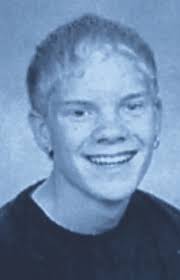
Jasmine Richardson was twelve years old when she murdered her entire family in a case that shocked the murder. According to court documents Jasmine and her much older boyfriend Jeremy Steinke would murder her mother, father and her younger brother.
Due to her age at the time police initially thought that Jasmine Richardson had been kidnapped however when they caught up with the couple the scary truth came out. This teen killer would be convicted on three counts of first degree murder however due to Canada sentencing laws when it comes to young offenders she was only sentenced to the maximum penalty of ten years in custody.
Jeremy Steinke who now goes by the name of Jackson May would be sentenced to three life in prison sentences with parole eligibility after twenty five years. Jasmine Richardson has been released from custody
Jasmine Richardson Other News
SOMEWHERE in Canada, perhaps near her parents’ old home in Medicine Hat, Alberta, where she massacred her own family, Jasmine Richardson is walking free.
It is 10 years since she slashed her little brother’s throat and left him to die among his blood-spattered toys, and waited on as her boyfriend stabbed her parents to death in a violent frenzy.
Three months ago, Jasmine Richardson faced a final court hearing and, freed of any court-ordered conditions, restrictions or supervision. She offered no apology or expression of remorse for what she had done.
Now the 22-year-old is living quietly in the community at a secret location. Richardson’s name cannot be published in her home country, where she is known as “JR” and she is even being described as “a poster child” for rehabilitation. But residents in the ordinary suburban neighbourhood near the Richardson family death house cannot forget and are not so sure that Jasmine Richardson should be living among them. “If you’re old enough to do the crime, you should do the time,” a woman told the Canadian Broadcasting Corporation.
Neighbours cannot forget April 23, 2006, a bright but freezing Spring day when a young boy spied bodies through the window of the Richardson family home, sparking a discovery that was to make Canadian criminal history. By that time, Richardson and her boyfriend, 23-year-old Goth and self-styled “300-year-old werewolf”, Jeremy Steinke, were on the run.
The neat grey weatherboard home with the gable roof and trimmed green lawn held grisly secrets that would shock the police who attended the scene. It was some time the previous night Jasmine Richardson, then aged 12, stabbed eight-year-old Jacob to death while her boyfriend, with her encouragement, murdered her parents. Detectives entering the home found Richardson’s parents in the basement and her brother in an upstairs bedroom.
They would later piece together the murder scene: Jasmine and Jeremy entered the home and Steinke killed his girlfriend’s mother first. Wearing a neoprene mask and carrying a knife he stabbed 48-year-old Debra Richardson 12 times, including a 12cm deep piercing to her heart. Hearing his wife’s screams, Marc Richardson, 42, came down the stairs to her aid and was set upon by Steinke who stabbed him 24 times, including nine times in the back. Jasmine reportedly wanted to take on her brother, eight-year-old Jacob, and climbed upstairs where he lay in his bedroom and stabbed him five times, including a wide, deep slash across his neck. Jacob would be found lying on his bed, surrounded by blood-splattered toys. When police arrived they at first feared 12-year-old Jasmine’s absence meant she had been kidnapped by the crazed murderer.
In reality, the pair had plotted the killings so they could run away together. Jasmine Richardson had met Steinke at a punk rock concert and immediately became intrigued by his goth lifestyle. Photographs on her MySpace page show how the clean cut young girl began changing under Steinke’s influence. Steinke had grown up with an alcoholic mother whose partners abused him. He was bullied by his classmates at school. A court later heard that by the age of 13, Steinke was diagnosed with depression and hyperactivity and later tried to hang himself.
Over the next 10 years he adopted the persona of the “300 year old werewolf” and wore a vial of blood around his neck. He had a user account at the VampireFreaks.com website and in 2006 he and Jasmine Richardson fell in love. Paramedics remove the bodies from the house where the murder scene traumatised detectives for years to come. When Jasmine’s parents discovered the relationship they forbade her from seeing him or going out. Online accounts belonging to both Steinke and Jasmine revealed that it was she who came up with the murder plan. Writing to Jeremy online, she said “I have this plan. It begins with me killing them and ends with me living with you.” Another message Steinke wrote on his Windows Live Spaces account about her parents read “Their throats I want to slit. They will regret the s*** they have done. Especially when I see to it that they are gone. They shall pay for their insulince [sic]. Finally there shall be silence. Their blood shall be payment!”.
Jasmine Richardson discussed her plans to kill her parents with her friends, but no-one believed her. On the night of the murders, Jasmine would later testify, her brother Jacob pleaded for his life and emitted a gurgling sound as she stabbed him, Steinke finishing him off by slitting his throat. She would later say that she killed him because it was too cruel to leave him without their parents. Two hours after the deaths Jasmine and Steinke were seen laughing and kissing at a restaurant. Soon after the pair’s arrest, Steinke asked Jasmine Richardson to marry him via letters from his prison cell, and she agreed.
Asked later why they committed the murders, Jasmine Richardson said: “I loved him so much. I thought it would bring us closer together”. In June 2007, aged 14, Jasmine Richardson went on trial for three counts of first degree murder. She was found guilty on all three and sentenced to 10 years jail, the maximum allowed by Canada’s Youth Criminal Justice Act. In 2008, Steinke was found guilty of three counts of first-degree murder and sentenced to three concurrent life sentences in prison, with an earliest parole date of 25 years. His lawyers argued that Steinke was in an alcohol and drug-fuelled haze when he “snapped” and stabbed Jasmine’s parents. They described him as a lovestruck, immature man who would do anything to keep the pre-teen girl’s affection. His friends testified that he had asked for help to get rid of the Richardsons because he was worried she would leave him if he didn’t. He claimed in his evidence that it was Jasmine who slashed her brother’s throat while he watched from a doorway.
The prosecution fought Steinke’s attempts to lessen the charges to second-degree murder to manslaughter, saying “a father … fought for his family’s life to his death. You had [Medicine Hat] police officers who mourned the loss … years later of the terrible things they saw.” Believed to be the youngest person ever convicted of a multiple murder in Canada, Jasmine was committed to a psychiatric hospital for four years. She spent a further four under conditional community supervision and was allowed to attend Mount Royal University in Calgary, Alberta. Announcing her absolute freedom in May, Queen’s Bench Justice Scott Brooker told her “I think your parents and brother would be proud of you. Clearly you cannot undo the past; you can only live each day with the knowledge you can control how you behave and what you do each day.”
Some of her old neighbours in Medicine Hat agreed Jasmine Richardson “should be given a second chance”. But Sue England told CBC she wondered “how she will continue on with her life with that being a part of her past life? … I have sympathy for her, but you can’t imagine anybody doing something like that”. Steinke has changed his name in prison to Jackson May and made a failed appeal against his sentence.
Jasmine Richardson Videos
Jasmine Richardson Photos


Frequently Asked Questions
Jasmine Richardson Now
Jasmine Richardson was released from prison and given a new identity











